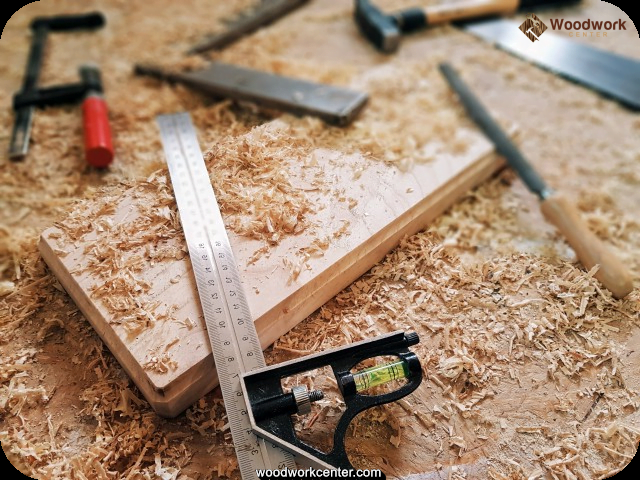Introduction
Woodworking is a craft of creating objects out of materials like timber, plastics and metals. It involves the combination of hand tools or machines, power tools, and physical skills. Woodworking plans in Illustrator involve the usage of Adobe’s vector imaging software to create detailed, technical drawings that can be used as guides by creators. Working with Illustrator allows woodworkers to produce three-dimensional designs with precision and accuracy.
Advantages of illustrating diagrams in Illustrator include the ease of editing parts which allows for improved accuracy, more flexibility in adjusting frame size while keeping relevant details intact, as well as crisp visuals with quality lines. Creative options are also available with built-in custom tools and effects such as gradients, transparency settings and text effects.
It is important to remember that designing woodwork plans entails more than just creating images; it should also consider the processes involved in manufacturing the product. Ideally, an illustration should be comprehensive enough for a manufacturer or buyer to assess for quality control measures without the need for further description separately.
Before starting any type of project involving design software like Adobe Illustrator, it is important to gather all relevant information needed such as measurements, scale dimensions or reference pictures if needed. This will help ensure a smoother process as one starts plotting out individual elements onscreen before connecting together into one whole outline template for final evaluation purposes.
Understanding Tools and Shapes
The tools used to draw shapes in Illustrator are the Rectangle Tool, the Pencil Tool, and the Pen Tool. The Rectangle Tool enables you to create rectangles, squares and circles of exact sizes. The Pencil Tool lets you sketch freehand lines and curves or draw with accuracy using the Smart Guides feature. With the Pen Tool, you can draw straight lines, curved paths and complex shapes by clicking on anchor points and manipulating its control handles.
When utilizing basic shapes like rectangles, circles or polygons in woodworking plans, it’s important to define their properties before drawing them – such as size and color. Moreover, these basic shapes can be easily edited in terms of shape, size or color along an illustrative journey.
To draw complex wooden structures that are seen in most woodworking plans (e.g., doors), users will need to use Illustrator’s line drawing tools alongside combined shapes capabilities – where several basic shapes form a structure when connected together – such as creating a door by joining four rectangles together at certain angles. In addition, when connecting multiple objects it is crucial to manually connect each point while appropriately zooming in so each connection point is visualizable from plan view. Finally, some necessary details may require manual adjustments through transforming individual elements via scaling or skewing for a perfect fit for all components being joined together on a wooden plan sketch.
Adding Details to Your Designs
When illustrating your woodworking designs in Illustrator, in order to create unique and detailed shapes you can modify and combine the basic shapes available using a variety of tools. For example, the Pathfinder tool can be used to join existing shapes together or break apart sections. The Shape Builder Tool will allow you to add new elements or ‘stitch’ together any number of objects by simply ‘clicking and dragging’ with your mouse. It is also possible to scale objects up or down as needed.
The Erase Tool is another great option when creating woodworking designs in Illustrator, allowing you to modify existing shapes by simply dragging the mouse. You can use this tool to add broader strokes and customized curves that can give dimension and shape to your design. In addition, the Eraser Tool works well for adding details such as grain lines within individual fibers of objects made from wood components.
Finally, once you are done editing and making customizations, Opacity Masking could further help define finer details within each portion of your illustrations. Opacity Masking produces smooth transitions between blended colors within an object which really assists with adding shadows and depth perception throughout a project plan illustration.
Sketching in Illustrator
Illustrator’s “Pen Tool” is invaluable in creating custom shapes and illustrating curves when it comes to woodworking plans. With the Pen Tool, you can create curves with an unmatched degree of precision, allowing you to accurately depict the intricacies of your design. For those looking for a more organic look, try drawing your woodworking plans and diagrams with traditional pencils or markers. Additionally, Illustrator’s airbrushes can be used for shading and adding dimension to your sketches. For a softer, hand-drawn look, consider using a brush pen and thinning out the nib with water. This combination allows you to mimic the same thin line quality of marker pens while giving each stroke a unique texture that looks distinctively handmade. Finally, don’t forget about combining different shapes and lines by overlaying them on top of each other. Utilizing this technique makes it easy to add depth and dimension to any illustration.
Adding Text
One of the most important components of creating a successful woodworking plan is making sure that the text accompanying it looks clean and professional. To help you maximize the appearance of your woodworking plans, here are some strategies and tips for designing text in Illustrator:
Choose an appropriate font. When selecting a font for your woodworking plans, make sure that the typeface expresses the level of professionalism and elegance desired – something classic such as Georgia or Helvetica can work well. Also consider any details that need to be emphasized, like titles or captions; bold type would be more appropriate for this purpose.
Construct custom text art. Text art can be used to enhance any woodworking plan and make it more eye-catching. To create custom text art, one simple technique is to use the Warp tools found in Illustrator. These will let you manipulate shapes by adding swells, bumps, or bends where needed to give your wooden elements some extra dimensionality when paired with a nice font. Alternatively, there are several pre-made “textured texts” available within Illustrator that you can use to quickly add texture or movement to your words without having to construct them yourself from scratch.
Layer text for added impact. Layering your text can have a huge impact on how appealing your plans look overall – try nesting important words or phrases inside larger frames of other words or images to draw attention towards them while emphasizing their importance. Play around with different blend modes and transparency settings to find the best combination for each particular element while also ensuring legibility amongst other elements located near it; good practice would be to not exceed 75% opacity when layering multiple pieces of information together (such as words and icons).
Utilize an effective layout grid system. Last but not least – if you’re feeling overwhelmed at the thought of organizing all your content into a neat overall look – feel free to utilize Illustrator’s many built-in grid templates or set up custom grids manually for assistance in setting up an attractive layout format (this goes double when working with notes that include both photographic imagery as well as text). It also helps if you make sure everything is evenly spaced out while keeping a consistent depth in terms of visual contrasting elements so things don’t become too messy looking with little regard among them all jumbled together haphazardly; breaking out lots of white space between two adjacent chunks of content helps this situation tremendously!
Finishing Touches
Shadows, highlights and colors can make woodworking plans look realistic and professionally finished. One technique to create depth involves fading colors from dark to light as one progresses from the foreground object to the background. When applying color to these plans, use shades of brown appropriate for the type of wood being expressed and develop a gradient effect by gradually lightening the colors as you move away from the focal point.
To further add realism, use Illustrator’s shadow tool in combination with transparency settings to render natural looking shadows that suggest a three-dimensional image. To get creative with perspective and composition, use various areas of focus within the same design project or layer objects on top of one another while using basic principles such as distance, size, contrast and scale within your imagery. Finally, don’t forget to utilize volume in your designs by creating shapes that give the sense of depth rather than flatness within your projects. All these techniques will help create a comprehensive look within any woodworking plan.
Tips for Experienced Illustrators
1) Pay attention to detail and accuracy. Even experienced illustrators can make mistakes when crafting a design. To ensure that your finished project is accurate, double check all measurements and angles. If a piece doesn’t seem to be 100 percent correct, take the time to re-examine your construction plans and check for any discrepancies.
2) Utilize the power of Adobe Illustrator’s layers and appearances. Being able to adjust individual elements in a design without impacting other parts is essential for creating complex images with little effort. Take advantage of layers and layer styles, as well as using the appearance panel to customize individual components, to create the perfect woodworking plan in an efficient manner.
3) Segment projects into sections when possible. Large woodworking plans can become difficult to maneuver in one single Illustrator file due to heavy amounts of pieces potentially becoming overwhelmed on the artboard. To combat this issue, use multiple artboards for different sections within the same project, allowing you to work on them separately while still having one unified approach that mimics the main idea behind it all.
4) Streamline your workflow by utilizing basic tools such as Blob Brush and Live Trace. For quickly tracing images into vectors or replicating certain styles repeatedly, these tools are particularly useful in any creative process as they allow you create high quality illustrations with minimum effort put into them.
5) Common mistakes made by inexperienced illustrators include adding too much detail or exaggeration instead of relying on a style that captures the essence of a design while still being visually appealing; making it difficult or impossible for anyone looking at the illustration to understand what is going on quickly; neglecting balance between aesthetics; using inflexible symbols instead of individual pieces for elements; not paying enough attention to industry standards when building layouts; overlooking actual dimensions compared with those from original sketch; overlooking photographic references if necessary; not taking advantage of modern software features such as innovative drawing brushes & effects etc.; not testing underlying logic before presentating results etc… To avoid making unacceptable errors or running into other issues when creating their designs, it’s important for illustrators learn which techniques work best in certain scenarios so they don’t compromise their productivity by testing out ideas they are unfamiliar with during production stage since it affects efficiency more often than expected
Conclusion
The process of illustrating woodworking plans in Adobe Illustrator is relatively easy with the right tools and techniques. Once you understand the basics, creating an accurate rendering of your project will become faster and easier. A helpful resource when starting out is Adobe’s official guide to Illustrator, which can be accessed online or through its app Help feature. Additionally, there are many tutorials available which can explain specific tools and techniques that can be utilized during the illustration process. As you continue to work on more complex illustrations with Illustrator, consider researching digital sculpting techniques that can turn your 2D drawings into 3D models. With practice and some extra effort, you will have no trouble creating detailed plan illustrations with ease and accuracy.

Hi everyone! I’m a woodworker and blogger, and this is my woodworking blog. In my blog, I share tips and tricks for woodworkers of all skill levels, as well as project ideas that you can try yourself.





